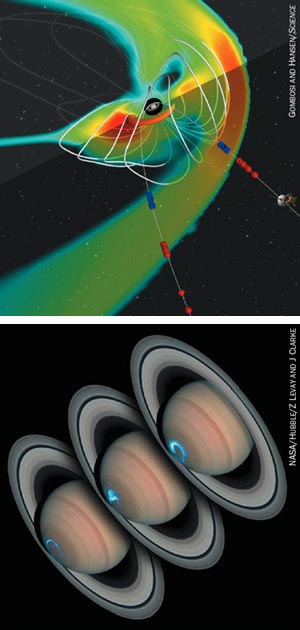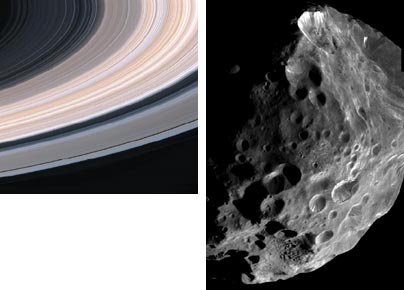The first results from the Cassini-Huygens mission provide an unprecedented view of the most complex planet in the solar system

The long wait since the launch of humankind’s most ambitious planetary-exploration mission to date is finally paying off. Launched in 1997, NASA’s Cassini spacecraft succeeded spectacularly in entering Saturn’s orbit last July, and earlier this year its payload – the European Space Agency’s Huygens probe – successfully landed on Saturn’s largest moon Titan. Now, eight months into Cassini’s four-year tour, the team behind the orbiter mission has released its first results (Science 307 1226-1276 and Nature 433 717-725).
We now have the first detailed glimpse of the Saturn system for a quarter of a century, when the Pioneer and Voyager probes made three “fly-bys”. The much closer look from the orbiting Cassini probe reveals many surprises in Saturn’s magnetosphere – and its glorious by-product the aurora – as well as spectacular views of the giant planet’s rings, atmosphere and its numerous icy satellites.
Magnetic surprise
Saturn is only the third planet, after the Earth and Jupiter, to have its magnetic environment studied in detail. Such planetary magnetospheres, which extend for between tens to hundreds of thousands of kilometres around a planet, are influenced by two key factors. The first is a supersonic stream of plasma from the Sun called the solar wind, which sends about a million tonnes of ions and electrons per second through the solar system. The second is the planet’s own magnetic field, in particular its orientation, strength and rotation rate.
These factors help shape a planet’s magnetosphere, with striking consequences. In the case of the Earth, the pressure of the solar wind pushes against its magnetic field on the sunward side and produces a comet-like tail on the night side. At the top of the ionosphere a limited region of relatively high-density plasma rotates with the Earth, well inside the boundary of the magnetosphere. But when the magnetic field of the solar wind has a southward component – i.e. in the opposite direction to the Earth’s polarity – small-scale magnetic reconnection occurs between the solar and planetary fields. As a result, the Earth’s magnetic field lines are “opened”, creating stress and driving the electrical currents between the magnetosphere and ionosphere that power the aurora.
In contrast, the magnetosphere of the gas giant Jupiter is dominated by rotation, and is filled with ionized material from its volcanic moon Io. Magnetic reconnection, while present, plays a secondary role. It was expected that Saturn’s magnetosphere would have a form somewhere between that of the Earth and that of Jupiter. However, it seems that Saturn’s magnetosphere is different.
During Cassini’s approach to Saturn in January 2004, the mission team joined forces with Hubble Space Telescope researchers to make an ambitious set of observations. Bill Kurth of the University of Iowa and co-workers measured the radio emission, Frank Crary of Southwest Research Institute and colleagues used the plasma-wave system to measure the oncoming solar wind, and John Clarke of Boston University and co-workers used Hubble to image Saturn’s aurora. As usual, the solar wind was gusty, and large shocks occurred on both 17 and 25 January. These shocks caused changes both to the aurora seen by Clarke and co-workers, and in the associated radio emission measured by the Cassini team, and the results show that both the solar wind and Saturn’s rotation play an important role in the planet’s aurora and magnetosphere (see figure).
The big surprise is that the solar-wind pressure, rather than the magnetic-field direction, has the largest effect on Saturn’s aurora. This is in contrast to both the Earth, where the north-south magnetic field dominates, and to Jupiter, where rotation dominates. It means that reconnection, while it is important in the tail of the magnetosphere, does not play the dominant role on the sunward side. Crary and co-workers, who discovered this effect, also suggest that it may be due to the nature of the solar wind at such large distances from the Sun, whereby the effect of solar-wind shocks outweigh that due to the orientation of the field.
Magnetospheric inventory
It was expected that the solar wind and Saturn’s rotation would play important roles in shaping its magnetosphere. However, another crucial factor was thought to be the interaction of charged particles coming from Saturn’s icy satellites, from Titan and from dust in the planet’s rings. Before Cassini’s instrumentation was able to provide the answer, the relative importance of such processes was not known.
Now Dave Young of Southwest Research Institute and co-workers have found that the inner magnetosphere is dominated by water and its products, such as atomic oxygen, from the icy satellites and from the diffuse so-called E-ring. Surprisingly, Saturn’s magnetosphere bears some resemblance to the coma of a comet, and most of it rotates with the planet.
Meanwhile, Larry Esposito and colleagues at the University of Colorado have measured the ultraviolet emission from neutral atomic oxygen and estimated the total mass of oxygen in the Saturn system to be about a million tonnes. The neutral to ion mixing ratio is some 30,000 times more than in the Jupiter system, and supports the idea that Saturn’s inner magnetosphere is dominated by water products that come from water ice.
Another surprise to Young’s team is that the expected nitrogen-rich torus surrounding the orbit of Titan due to the satellite’s thick atmosphere is apparently absent. Nitrogen, probably from Titan, is seen in small quantities in the inner magnetosphere, although further work is needed to understand why.
Atmospheric rings
Saturn’s glorious rings are one of the main targets of the Cassini mission. It is anticipated that the ring particles, bombarded by magnetospheric particles and by meteorite impacts, may provide enough neutral material to offer a thin atmosphere and ionosphere. Cassini is the first spacecraft to fly close enough to Saturn’s rings to “taste” the composition of these regions.
Remarkably, Dave Young and co-workers, along with Hunter Waite’s team working with Cassini’s ion and neutral-gas spectrometer, have found that the atmosphere of the water-rich rings is dominated by molecular oxygen, just like the atmospheres of Jupiter’s moons Ganymede and Europa. The molecular oxygen, along with atomic oxygen and other water products, is thought to be produced when sunlight strikes Saturn’s rings, and, unlike other products, it does not stick back onto the frigid ring particles.
Young’s team also found that the intensity of photoelectrons seen from the far, sunlit side of a ring depends on the optical depth of the ring, and is found to peak in gaps between the rings. These features may be related to spokes in Saturn’s rings that were seen by Voyager but not yet observed by Cassini. According to Carolyn Porco of the Space Science Institute in Colorado, the lack of spokes could simply be due to a geometrical or seasonal effect. Meanwhile, Sascha Kempf and colleagues from the Max Planck Institute for Nuclear Physics in Heidelberg, using Cassini’s cosmic-dust analyser, detected a stream of dehydrated dust from Saturn’s rings during the probe’s approach, apparently charged and accelerated by the magnetosphere.
Saturn’s version of the Earth’s Van Allen radiation belts, which lie well within the magnetosphere, provide another surprise. We already knew that some of the energetic particles that are so hazardous to spacecraft in other magnetospheres are soaked up by Saturn’s rings. But Tom Krimigis of Johns Hopkins University and colleagues have discovered a new, unexpected belt inside the main rings. They suggest an exotic mechanism for this so-called double charge exchange: particles in the main radiation belt outside the rings first undergo a charge-exchange reaction with exospheric material, after which they cross the ring regions as neutral particles and then undergo a second charge-exchange reaction in the inner region. Finally they are trapped in the planet’s magnetic field.
Changing faces
Michele Dougherty and colleagues from Imperial College in the UK have concluded that the solar wind must have changed significantly during Cassini’s first orbit. On the way in to the orbit, the outer boundaries with the solar wind were observed to be much further away from the planet than usual, but these boundaries were much closer to the planet on the way out. The UK-lead team also detected the first artificially produced “ion cyclotron” waves at another planet, which were associated with the main engine burn used to slow Cassini into orbit.
Another study carried out by Don Gurnett of the University of Iowa and colleagues reveals that Saturn’s rotation period has apparently slowed by six minutes to 10 hours, 45 minutes and 45 seconds since Voyager’s visit in 1980. They suggest that the tilt between the spin and magnetic axes, confirmed to be less than 1 degree by Cassini’s magnetometer, may not be enough to explain this change, and that “slippage” in the magnetosphere may play a role. In other words, the magnetosphere may rotate slower than the upper atmosphere of the planet, perhaps due to the accretion of additional mass since Voyager’s visit.
Saturn’s atmosphere has also changed. The equatorial winds measured by Voyager had a speed of about 500 m s-1, while Hubble measurements taken between 1996 and 2004 showed slower winds at a speed of about 275 m s-1. By observing cloud features, Porco and colleagues have now found an intermediate value of 375 m s-1, attributing the change to seasonal variations or cloud activity.
Saturn is second only to Jupiter in its number of moons. In addition to the planet-like Titan, there are currently 34 known icy moons – three of which were discovered by the Cassini probe. Phoebe, which orbits Saturn in the opposite direction from all the other major moons, was known to be a captured object from about 4 billion years ago. However, before Cassini arrived we did not know whether Phoebe was a captured asteroid or comet. The new results, from teams led by Porco, Esposito, Bob Brown and Mike Flasar, clearly show that Phoebe has cometary features – a dark surface with visible traces of ice. This means that the origin of the moon is the outer solar system.
Another one of Saturn’s major satellites is Iapetus, one face of which is 10 times darker than the other. Porco’s results imply that the darker face is probably due to the accumulation of external material, rather than an internal process. However, internal processes are also significant, leading, for example, to a newly discovered equatorial ridge on the dark face. Indeed, Porco and colleagues have unearthed a treasure trove of new data on Saturn’s rings and satellites. These include the discovery of new moons called Methone, Pallene and Polydeuces, new material near the “F-ring” and observations of the effects of moons on the rings.
Overall, the results presented from this early part of the Cassini mission provide an awesome taste of things to come, with new discoveries announced in several different fields. By the time Cassini has completed its 75 orbits, 45 Titan fly-bys and 8 close icy-satellite fly-bys in 2008, we will have re-written the textbooks on Saturn and its system. This is only the beginning.




